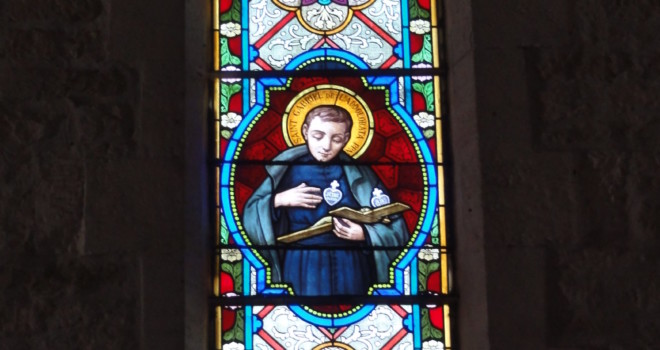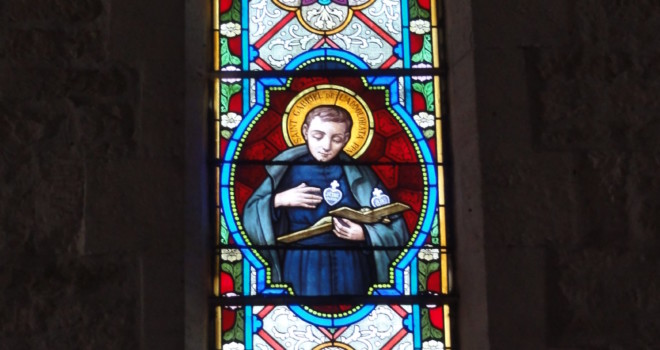In 2016, we
lost our third child to miscarriage. Our oldest daughter was five years old
at the time, and she had been eagerly anticipating the birth of her new brother
or sister later that year. Our baby was too young to determine whether or not
it was a boy or girl, but we both felt in our hearts that he was a little boy.
The evening before his remains were surgically delivered, we knew we wanted to
pick his name, so that our Catholic obstetrician could give him a conditional
baptism. In an effort to console our heartbroken preschooler, we asked her if
she wanted to name her baby brother.
She sat with her little picture book of saints, and
carefully turned the pages. Finally, she stopped, pointed to a picture and asked,
“Who is that, Mommy?”
“That’s St. Gabriel of Our Lady of Sorrows.”
“That’s who I pick, because he looks a little bit sad, like
me.”
Since we also loved St. Gabriel the Archangel, we decided
that he would be our little Gabriel. At the time, I knew little of St. Gabriel
of Our Lady of Sorrows, but I now see how truly fitting that patron was for my
little son.
Gabriel (born Francis) lived a simple life, and died at the age of 24. He was a member of the Passionists, but he died before he was ordained a priest. He didn’t do anything remarkable by the world’s standards, but he did suffer. And many of the sufferings that he endured (such as his final battle with tuberculosis) were hidden.
All mothers who miscarry children find themselves wondering
who their child would have been. What would he have done? How would he have
looked? How old would he be right now, if he had lived? What difference would
he have made in the world?
I have wondered all of these things about my Gabriel, but I
have also felt deeply that God’s plan for him is not over – it is just
different from the plan he has for my living children. Our family has
experienced the effects of the intercession of our little saint on more than
one occasion. Although I don’t know how God is using him, I know that God is using
my son in hidden ways that I will not understand in this life.
My son was so young and so small that hopefully he never knew
suffering. He also never knew the consolation of being held in his (earthly)
mother’s arms. But truly – I don’t know what he experienced. His life was a
hidden one, just like his patron saint’s life was.
Although saints whose lives are more heroic, interesting, and visible may capture our imaginations, the reality is that most of us will not be called to be that sort of saint. Most of us will endure quiet, daily white martyrdoms — not red ones. Most of us will walk paths of sainthood that consist of hidden suffering. Were we to consider that possibility in the eyes of the world, it would seem that we were destined for failure. Not only does the world glance askance at suffering, it also fails to understand hiddenness.
God’s ways, however, are not like the ways of the world. He
chose to become incarnate as a poor child in a stable. He died a criminal’s
death. He sought not greatness, but suffering. And in his suffering, he showed
us the greatness of his love.
This year, the feast of St. Gabriel of Our Lady of Sorrows
comes the day after Ash Wednesday. It is a fitting beginning to our Lenten
season. How often are we tempted to choose showy or complicated penances for
ourselves during Lent, when what God asks of us is often small and hidden? We
may want to give up social media for Lent, publishing our practice with the
appropriate meme– but what if God instead wants us to give up complaining about
people on social media? We may want to take on some great practice of piety –
but what if God is asking us to take time to say something kind to our spouse
every day instead? Although the former practices may seem to be the more acceptable,
holy ones, Jesus reminds us that God wants “mercy not sacrifice” …and often
the greatest sacrifice is the hidden practice of mercy. This does not mean that
we shouldn’t undertake more traditional practices of piety or penance,
but it does mean that we should discern how God is asking us to sacrifice our
own desire for greatness, that we may manifest his mercy in hidden ways.
Gabriel of Our Lady of Sorrows knew the truth of this. His quiet, mostly hidden life of suffering was short, yet…it was a life lived in the heart of God’s mercy. His suffering was lovingly embraced from that perspective. As this Lent begins, let us do the same.
✠
image: Shrine of Gabriele dell’Addolorata window by Havang(nl) / Wikimedia Commons (CC0)












